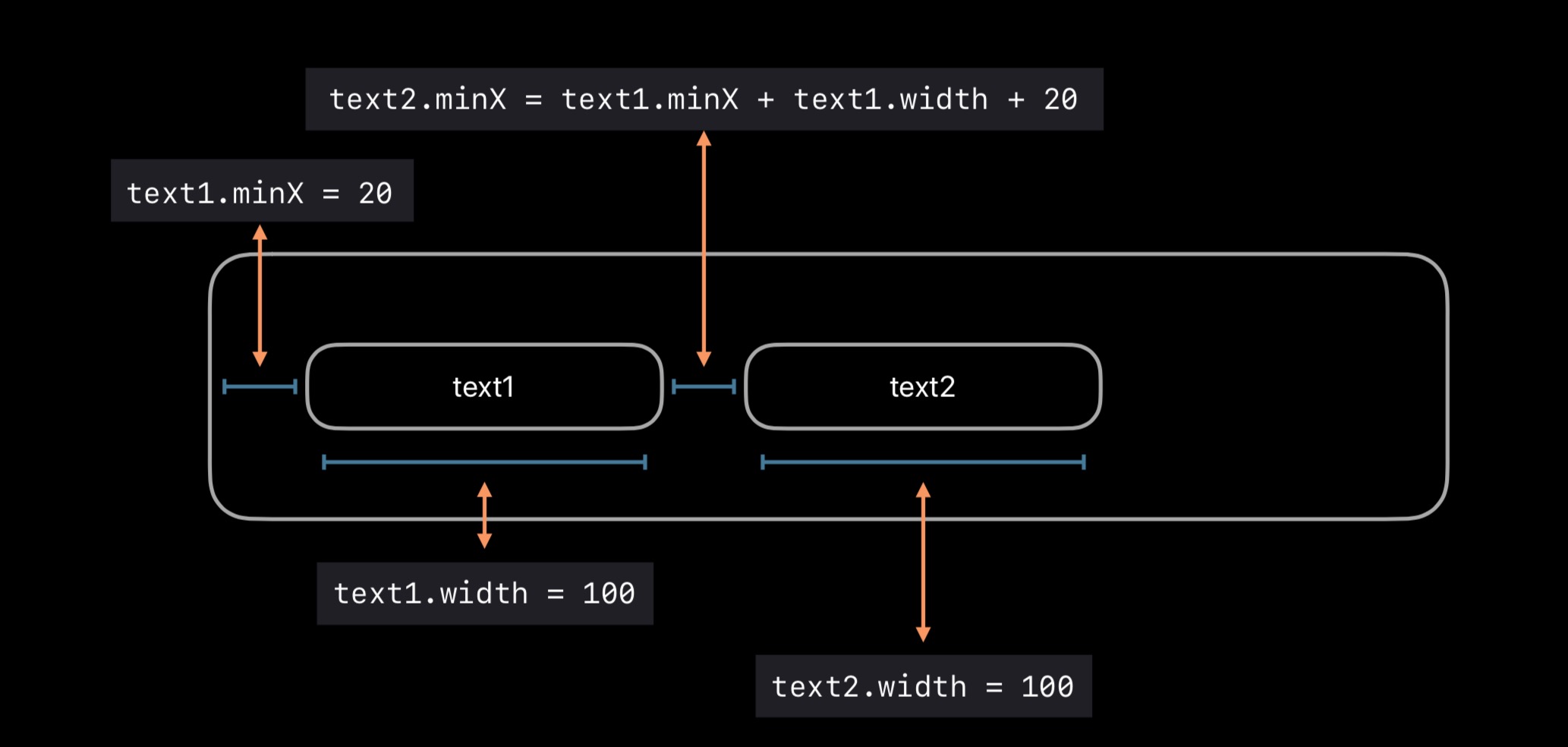最近总算有点时间写博客了,这次讲的是WWDC 2018中的Session 220 High Performance Auto Layut
AutoLayout作为平时用的最多的布局方案,但是在性能上总是饱受病垢,通过这个session,我们可以了解到AutoLayout是怎么工作的,以及在iOS 12上AutoLayout得到了怎样的提升。
正文
talk is cheap,show me the code
先上来就是一段代码,告诉了我们,不要每次更新约束的时候,都把所有的约束移除,这样是错误的:
// Don’t do this! Removes and re-adds constraints potentially at 120 frames per second
override func updateConstraints() {
NSLayoutConstraint.deactivate(myConstraints)
myConstraints.removeAll()
let views = ["text1":text1, "text2":text2]
myConstraints += NSLayoutConstraint.constraints(withVisualFormat: "H:|-[text1]-[text2]",
options: [.alignAllFirstBaseline],
myConstraints += NSLayoutConstraint.constraints(withVisualFormat: "V:|-[text1]-|",
metrics: nil, views: views)
options: [],
metrics: nil, views: views)
NSLayoutConstraint.activate(myConstraints)
super.updateConstraints()
}
而且从这段注释就隐约透露了,尽管目前不能达到120fps,但是在未来的iPhone很有可能能达到120fps,所以并不建议我们这样操作。
正确的做法应该是通过懒加载的方式,如果已经添加了约束,就不需要再移除,再添加了:
// This is ok! Doesn’t do anything unless self.myConstraints has been nil’d out
override func updateConstraints() {
if self.myConstraints == nil {
var constraints = [NSLayoutConstraint]()
let views = ["text1":text1, "text2":text2]
constraints += NSLayoutConstraint.constraints(withVisualFormat: "H:|-[text1]-[text2]",
options: [.alignAllFirstBaseline],
metrics: nil,
views: views)
constraints += NSLayoutConstraint.constraints(withVisualFormat: "V:|-[text1]-|",
options: [],
metrics: nil,
views: views)
}
NSLayoutConstraint.activate(constraints)
self.myConstraints = constraints
super.updateConstraints()
}
为了更好让我们理解“为什么要这么做”,而不是让我们知道“就是得这样做”,这个session给出了更详细的解释。
当我们创建了一个View,给这个View去添加约束的时候,会创建一个和约束对应的等式,将其添加到计算约束的引擎中,引擎会将约束解释成视图的布局变量,最终设置视图的x,y,width,height。
例如我们要创建下图的视图关系:

约束会转换成以下的等式:

text1.minX = 8
text1.width = 100
text2.minX = text1.minX + text1.width + 20
最终将变量代入公式中得到最终的值:
text1.minX = 8
text1.width = 100
text2.minX = 8 + 100 + 20
text2.width = 128
到这里为止,引擎对这个布局的计算就已经完成了。
每当引擎将计算得到的值赋值给变量的时候,它会告诉视图,你的变量已经发生了改变,这时候视图则会调用Superview.setNeedsLayout()通知父视图发生了变化,然后视图会执行layoutSubviews(),同时询问引擎变化的值是什么,引擎告诉视图的值,就会调用setBounds()和setCenter(),然后完成整个布局的过程。
如果希望在使用AutoLayout的时候,提高性能,在遇到一个视图,会发生改变的时候,不要removeAll(),这样会造成约束流失,导致性能下降。而是在不需要使用的时候,调用deactivate()使约束暂时失效,而再次需要用到的时候调用activate()再次激活。
我们在使用AutoLayout的时候,大多数会使用一些第三方库,而不会直接使用苹果原生提供的VFL或者其他原生api,在Objective-C中会使用Masonry,在Swift中会使用SnapKit,下面以SnapKit为例子:
var firstConstraint: Constraint?
var secondConstraint: Constraint?
func setupLayout() {
view.snp.makeConstraints { make in
firstConstraint = make.bottom.equalTo(otherView.snp.bottom).constraint
secondConstraint = make.bottom.equalToSuperview().constraint
}
firstConstraint?.activate()
secondConstraint?.deactivate()
}
func updateLayout() {
let something: Bool = ...
if something {
firstConstraint?.activate()
secondConstraint?.deactivate()
} else {
firstConstraint?.deactivate()
secondConstraint?.activate()
}
总结
剩下一部分是比较零散的小技巧,所以放到总结中:
- 在使用优先级的时候,引擎会进行更多的计算,导致性能下降。
- 在视图中的子试图存在不同状态的时候,需要显示或移除的时候,可以优先考虑使用隐藏视图、激活约束、失效约束去避免约束流失。
- 部分控件是具有固定尺寸的,例如UIImageView会根据UIImage的大小去适应尺寸,原理也是通过UIView创建约束,你可以自己去设定大小,这样就会跳过系统计算约束的步骤,但是不要认为这样可以提高性能。但是有一种情况下是可以提高性能的,就是在使用UILabel的时候,如果你自己手动去计算label的size的时候,可以通过重写
var intrinsicContentSize: CGSize属性,告诉系统不需要帮我们计算。override var intrinsicContentSize: CGSize { return CGSize(width: UIView.noIntrinsicMetric, height: UIView.noIntrinsicMetric) } - 尽可能少调用
systemLayoutSizeFitting(_:)方法,它会临时创建一个引擎,然后返回size之后丢弃,频繁的调用,会造成性能下降。
请保持转载后文章内容的完整,以及文章出处。本人保留所有版权相关权利。